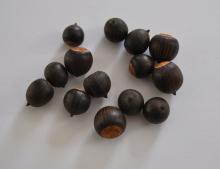
We here at the UMD Arboretum and Botanical Garden are taking part in an initiative founded in 1999 called the Global Tree Campaign. The focus of this campaign is to protect and preserve native endangered trees, and of the several North American trees listed on the Global Tree Campaign website, we found ourselves enamored with the Georgia Oak. The Georgia Oak (Quercus georgiana) is an endangered species native to the southeastern region of North America, specifically in Georgia and Alabama. It’s found growing on naturally occurring granite outcrops in the Piedmont physiographic region. Q. georgiana has naturally adapted to growing in shallow, rocky soil conditions – which is one of a few factors that make this species more vulnerable. In the areas this tree naturally grows, foot traffic on adjacent trails can compact the soil surrounding its naturally shallow roots and proves damaging, and in some cases fatal to the tree. Mechanical disturbances such as soil compaction, as well as ever warming global temperatures and cases of drought threaten the vitality of this oak. Lower population numbers also weaken genetic diversity of the species, weakening its reproductive viability. This tree was listed as endangered in 1998.
After doing our homework on the plant, one of our interns contacted a member of the Georgia Forestry Commission and was able to secure a few dozen acorns for the project. According to Michael A. Dirr in Manual of Woody Landscape Plants, this is a “species related to Q. palustris,” the pin oak. With this information, and under advisement from Institute of Applied Agriculture lecturer Ken Ingram, we are treating Q. georgiana’s acorns as we would a member of the red oak family by cold stratifying the acorns before planting them. Cold stratification mimics the natural conditions an acorn of this variety must go through to properly germinate and subsequently, grow to a seedling. After their time in the cooler, we will then pot the acorns and give them a good head start in our greenhouse before placing them around our campus.
We are very excited to take a role in seeking to help preserve this wonderful U.S. native tree. Due to the tree’s ability to tolerate harsher soil conditions, we hope our trees can grow very comfortably here on campus. Dirr describes the Georgia oak as a 15’-30’ tall, densely branched tree with a lustrous green summer foliage and a beautiful reddish purple fall color, surely a gorgeous addition we look forward to showcasing within our school’s landscape. Keep an eye out for updates to the progress of our new additions here at The University of Maryland’s Arboretum and Botanical Gardens!
Written by Mark Santamaria and Richard Jones
Information was collected from Michael Dirr’s Manual of Woody Landscape Plants (Champaign, Illinois: Stripes Publishing, LLC, 1998), The IUCN List of Endangered Species website (http://www.iucnredlist.org/details/34011/0), and information and images were collected from The Global Tree Campaign website.
